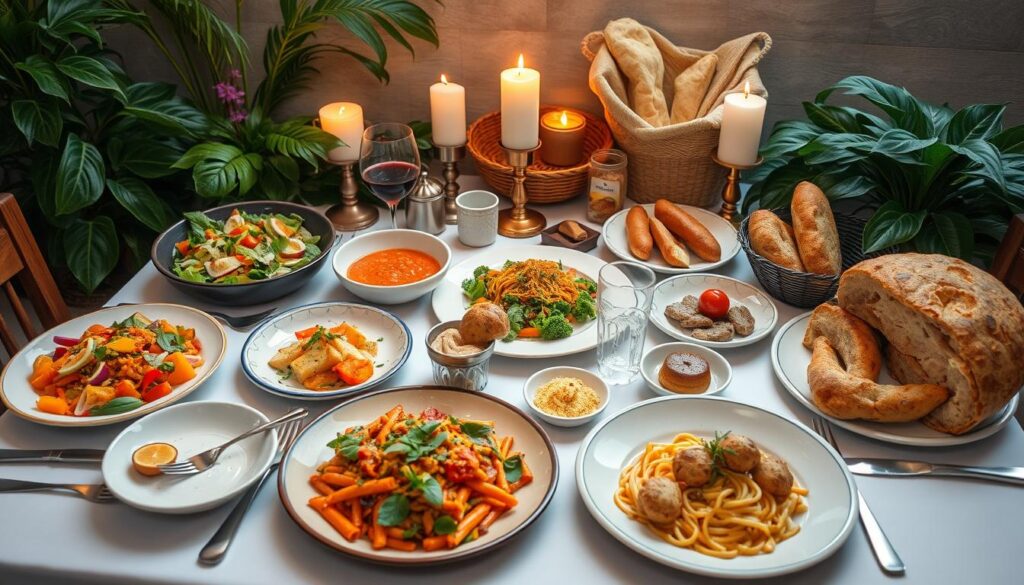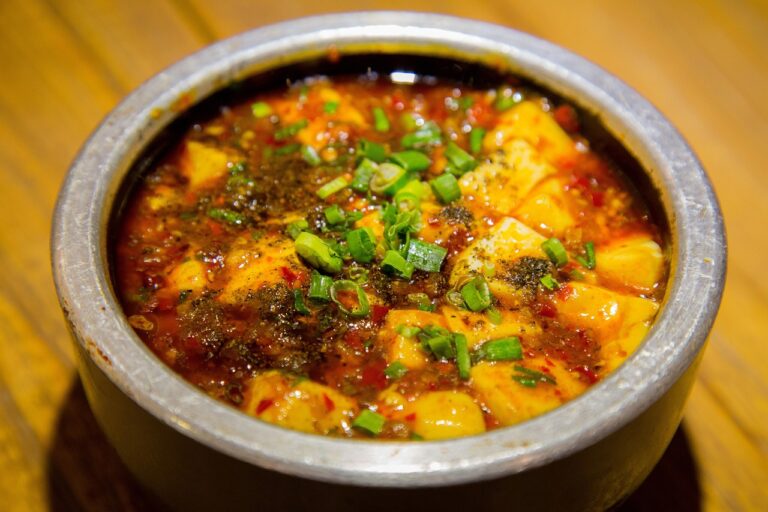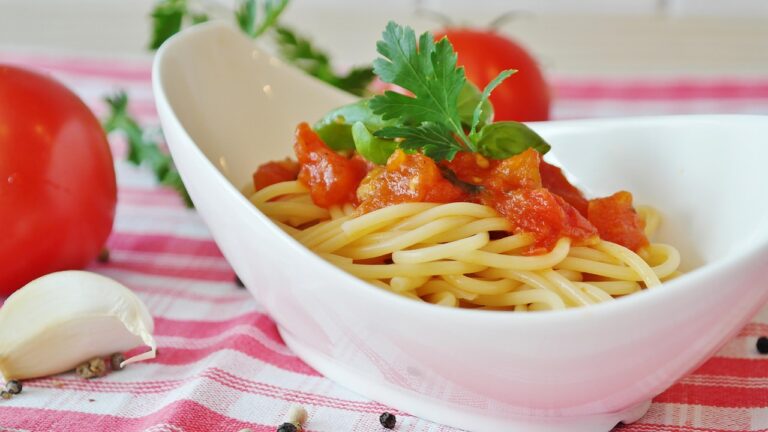Delicious Recipes to Savor Every Moment
Cooking is a big part of our daily lives. Trying new recipes can make our meals more exciting. With the right ingredients and techniques, anyone can make delicious dishes.
Delicious recipes are not just about food. They’re about sharing moments and making memories with loved ones. Recipes can be simple or complex. The goal is always to make something tasty.
Cooking lets us explore new flavors and ingredients. It’s about finding new ways to make recipes.

Cooking and trying new recipes is fun and rewarding. It lets us be creative and bring people together. Whether cooking for ourselves or others, the aim is to make something delicious.
Delicious recipes are about enjoying the cooking process. They’re about sharing meals and making memories. Recipes help us connect with others and create lasting memories.
Introduction to Delicious Recipes
Cooking lets us discover new flavors and ingredients. With practice and patience, anyone can become a skilled cook. It’s not just about following a recipe. It’s about understanding the techniques and ingredients that make a meal delicious.
Recipes are a great way to learn new cooking techniques. They let us experiment with new flavors and ingredients.
Key Takeaways
- Cooking is an essential part of our daily lives
- Exploring new recipes can add excitement and variety to our meals
- Delicious recipes to savor every moment are about sharing experiences and making memories
- Cooking is about exploring new flavors and ingredients
- Recipes can be a great way to connect with others and create lasting memories
- Cooking is a fun and rewarding experience that allows us to express our creativity
- Delicious recipes to savor every moment are about taking the time to enjoy the process of cooking and sharing meals with others
Understanding the Art of Everyday Cooking
Everyday recipes are a great way to start cooking. They help you explore new flavors and techniques. Cooking is an art that needs patience, practice, and the right tools. With the right equipment and creativity, anyone can cook delicious food that brings people together.
Having the right equipment is key in everyday cooking. You’ll need good knives, pots, and pans. Basic techniques like boiling, steaming, and sautéing are also important. Choose fresh, seasonal ingredients for the best flavor and texture.
Essential Kitchen Equipment
- Good set of knives
- Pots and pans
- Cooking utensils, such as spoons and spatulas
Basic Cooking Techniques
- Boiling
- Steaming
- Sautéing
Ingredient Selection Guidelines
When picking ingredients, think about these factors:
- Seasonality
- Freshness
- Quality
By following these tips and practicing basic techniques, you can become a skilled cook. You’ll make delicious everyday recipes that bring people together. Cooking for yourself or others is rewarding and fun for everyone.
| Ingredient | Seasonality | Freshness |
|---|---|---|
| Apples | Fall | High |
| Carrots | Spring | Medium |
| Broccoli | Winter | High |
Planning Your Culinary Journey
Exploring new recipes needs a clear plan. You might want to master certain cooking techniques or try out different flavors. A good plan keeps you focused and motivated, making your cooking journey fun and fulfilling.
To start, consider these steps:
- Know what you want to achieve in cooking, like making gourmet meals or trying new recipes from everywhere.
- Look into various ingredients and flavors to see what you like best.
- Try out different cooking methods to find what works for you.
By taking these steps, you’ll create a cooking plan that fits your taste and style. Be open to new ideas, as the world of recipes and flavors is always changing. With a solid plan, you’ll feel confident and skilled in gourmet cooking.
As you start your cooking journey, don’t hesitate to try new things and go beyond what you’re used to. With time and effort, you’ll develop a cooking style that shows off your favorite recipes and flavors. Cooking for yourself or others is more about the journey than the end result.
| Culinary Objective | Ingredients | Cooking Techniques |
|---|---|---|
| Mastering gourmet meals | Fresh produce, herbs, and spices | Sous vide, roasting, and grilling |
| Exploring new recipes | International ingredients, such as soy sauce and kimchi | Stir-frying, braising, and steaming |
Mastering Time-Saving Kitchen Techniques
Cooking can take a lot of time. But, with the right techniques, you can save time and effort. Learning how to cook quickly is key for busy people who want to make tasty meals fast.
One great way to save time is to do prep work ahead. This means chopping veggies, marinating meat, and measuring ingredients. Doing these tasks early can make cooking faster. For instance, a stir-fry can be ready in under 30 minutes if you prep everything first.
Prep Work Strategies
- Chop vegetables and store them in airtight containers
- Marinate meat and seafood in advance
- Measure out ingredients for common recipes
Another way to save time is to multi-task in the kitchen. You can cook several dishes at once or use a slow cooker. This way, you can make more meals with less effort. With practice, you’ll get better at saving time while cooking.
Smart storage is also important for saving time. Keeping your kitchen organized helps you find what you need fast. This is especially helpful for making simple dishes like soups or salads.
Delicious Recipes to Savor Every Moment: A Complete Guide
Making delicious recipes to savor every moment needs skill, the right ingredients, and how you present them. This guide will cover cooking techniques, picking the best ingredients, and presentation ideas. You’ll learn to make meals that everyone will remember. By trying new flavors and ingredients, you can create your own special recipes to share with loved ones.
Choosing the right ingredients is key to making delicious recipes. Fresh, seasonal ingredients can turn a simple dish into something amazing. Here are some tips for picking ingredients:
- Go for locally sourced produce for the best taste and freshness.
- Pick high-quality proteins like grass-fed meats or wild-caught fish.
- Try new and exotic spices to add depth and complexity to your dishes.
How you present your dish is also very important. A beautifully presented dish can greatly enhance your dining experience. Here are some presentation tips:
- Use colorful and fresh garnishes like herbs or edible flowers.
- Make your dish look good by creating patterns and designs on the plate.
- Play with different textures and heights to add interest to your dish.

By using these tips and trying new ingredients and presentation styles, you can make your own unique recipes. Whether you’re an experienced cook or just starting out, cooking is all about trying new things and being creative. So, why not start today and enjoy the fun of making delicious recipes to savor every moment?
Seasonal Ingredients for Maximum Flavor
Using seasonal ingredients is key to making tasty dishes. It ensures ingredients are fresh and of high quality. This way, you can enjoy a variety of flavors all year round.
Seasonal ingredients make dishes more flavorful. For example, spring and summer veggies and herbs add a burst of taste to salads and soups. Meanwhile, fall and winter ingredients like root veggies and warm spices create cozy, comforting dishes.
Spring and Summer Selections
Spring and summer bring strawberries, blueberries, and stone fruits. These can be used in salads, smoothies, and baked goods. They add a refreshing twist to traditional recipes.
Fall and Winter Favorites
Fall and winter bring pumpkins, squash, and apples. These are great for making warm dishes like soups and pies. They also add flavor and texture to roasted veggies and meat stews.
Year-Round Pantry Essentials
There are also pantry staples that add flavor all year. Olive oil, salt, and pepper are must-haves. So are spices and herbs like basil and thyme. Mixing these with seasonal ingredients lets you make a wide range of tasty dishes.
| Season | Ingredients | Dishes |
|---|---|---|
| Spring | Strawberries, blueberries, stone fruits | Salads, smoothies, baked goods |
| Summer | Tomatoes, corn, bell peppers | Grilled vegetables, salads, soups |
| Fall | Pumpkins, squash, apples | Soups, stews, pies |
| Winter | Root vegetables, warm spices | Hearty stews, roasted vegetables, meat dishes |
Creating Memorable Dining Experiences
To make dining special, focus on the little things. Use soft lighting and pleasant music to set the mood. Choose the best ingredients for your dishes and present them beautifully. This way, homemade meals can be as impressive as restaurant food.
For memorable meals, pick fresh, seasonal ingredients. Try new flavors and recipes. Make your dishes look good by paying attention to presentation. Add a personal touch by using family traditions or cultural recipes. For example, try making British dishes like fish and chips or roast beef. Or, experiment with Italian or Indian cuisine.
Here are some ideas for memorable dining experiences:
- Host a dinner party with friends or family
- Try a new recipe or cooking technique
- Use seasonal ingredients to create a themed meal
- Pay attention to the presentation of your dishes

By following these tips, you can impress your loved ones. Whether it’s a special occasion or just a regular meal, focus on the details. Have fun and be creative. This way, every meal can become a memorable culinary delight.
| Meal Idea | Ingredients | Presentation |
|---|---|---|
| Summer Salad | Fresh vegetables, fruits, and nuts | Arrange ingredients in a colorful pattern on a large platter |
| Winter Stew | Hearty meats, vegetables, and grains | Serve in a large bowl with a swirl of cream and a sprinkle of herbs |
Elevating Simple Dishes to Gourmet Status
Turning everyday meals into gourmet dishes takes creativity and skill. By using simple yet effective methods, anyone can make their cooking stand out. This is especially true when it comes to plating techniques, which are key to presenting a dish attractively.
In the world of food, how a dish looks matters a lot. A beautifully presented dish can greatly enhance your dining experience. Here are some tips to help you achieve this:
- Balance: Make sure the elements on the plate are balanced and look good together.
- Color: Add color to your dish with fresh herbs or edible flowers.
- Texture: Mix different textures to make your dish visually appealing.
When cooking, making your dish taste great is essential. You can do this by trying out different recipes and techniques. For instance, a simple grilled chicken can be made more exciting with a marinade of olive oil, lemon juice, and herbs.
Adding a garnish can also give your dish a special touch. This could be as simple as sprinkling parsley or adding a slice of lemon. By using these techniques, you can make your dishes taste and look like they came from a fancy restaurant, even with simple recipes and everyday ingredients.
| Technique | Description |
|---|---|
| Plating | Presentation of the dish |
| Flavor Enhancement | Using various methods to enhance the flavor of the dish |
| Garnishing | Adding a finishing touch to the dish |
Making the Most of Leftovers
Learning to use leftovers is key in cooking. It cuts down on food waste, saves money, and saves time. Turning leftovers into new dishes lets you enjoy different tastes without starting over.
Plan your meals around leftovers. For instance, leftover roasted veggies can turn into a tasty soup or stir-fry. Here are some tips to help you:
- Turn last night’s dinner into tomorrow’s lunch
- Freeze leftovers for future meals, like soup or casseroles
- Be creative with leftovers, like making fried rice with leftover rice or croutons from leftover bread
These tips help you waste less food and make the most of your cooking. Whether it’s a simple or complex dish, using leftovers saves time and money. Plus, you get to enjoy a variety of flavors.
| Recipe | Leftover Ingredients |
|---|---|
| Chicken Salad | Leftover chicken, celery, onion |
| Vegetable Soup | Leftover vegetables, broth |
| Fried Rice | Leftover rice, vegetables, meat |
By using leftovers in your cooking, you can enjoy many homemade meals. This also helps reduce food waste and saves you time.
Adapting Recipes for Different Dietary Needs
Cooking for everyone means considering different diets. We can change recipes to fit needs like vegetarian, gluten-free, and low-carb. This way, everyone can enjoy tasty meals, no matter their dietary limits.
Cooking is all about being creative and flexible. Changing recipes lets us try new tastes and ingredients. For example, swapping out gluten for gluten-free options helps those with gluten issues.
Vegetarian Variations
Vegetarian dishes are full of variety, from hearty stews to tasty stir-fries. Adding beans, lentils, and tofu makes meals both filling and healthy. Favorites include veggie curries, quinoa salads, and roasted veggie bowls.
Gluten-Free Options
Gluten-free cooking means using ingredients like rice, corn, and quinoa instead of wheat. We use gluten-free flours like almond or coconut. It’s also important to avoid gluten in other foods to prevent cross-contamination.
Low-Carb Alternatives
Low-carb recipes cut down on carbs by swapping out high-carb foods for lower ones. We might use cauliflower instead of rice or choose veggies like leafy greens and broccoli. This way, we can enjoy healthy, tasty meals that fit our dietary needs.
Trying new recipes and cooking methods helps us appreciate food more. It brings people together, whether it’s a family dinner or a party. Adapting recipes makes any meal memorable and fun.
Building Your Recipe Collection
Creating your own recipe collection is key to becoming a great cook. It lets you try new cooking methods, mix different ingredients, and find your own cooking style. Organize your recipes by meal type, ingredient, or cooking method for easy access.
A good recipe collection helps you plan meals, shop for ingredients, and cook with confidence. Include both simple and complex gourmet recipes. Start by gathering your favorite recipes and organizing them in a way that works for you.
Here are some tips for growing your recipe collection:
- Begin with basic recipes and then add more
- Try new ingredients and cooking methods to add variety
- Consider making a digital or physical recipe book
By following these tips and adding to your collection, you can develop a unique cooking style.
Remember to have fun and be creative as you build your collection. Try new recipes, experiment with ingredients, and don’t worry about mistakes. Over time, you’ll have a collection of gourmet recipes that show your personal taste and improve your cooking skills.
| Recipe Type | Description |
|---|---|
| Breakfast | Recipes for morning meals, such as eggs, pancakes, and oatmeal |
| Lunch | Recipes for mid-day meals, such as sandwiches, salads, and soups |
| Dinner | Recipes for evening meals, such as pasta, stir-fries, and roasts |
Conclusion: Embracing the Joy of Cooking
Starting your cooking journey is exciting. It’s not just about the food you make. It’s about the fun of creating something special and delicious.
Learning new cooking skills and using fresh ingredients opens up a world of flavors. You’ll find joy in making meals at home.
Cooking lets you be creative and share meals with loved ones. It’s a way to show love and care through food. Enjoy every step, from chopping veggies to plating your dish.
Keep adding to your recipe collection and improving your cooking. Remember, it’s all about having fun. Every new recipe you learn shows your growth as a chef.
So, enjoy the journey of cooking. You’ll make delicious memories that you’ll always treasure.
FAQ
What are the essential kitchen equipment needed for everyday cooking?
A sharp chef’s knife, cutting board, and saucepans are must-haves. Skillets, mixing bowls, and measuring cups and spoons are also key. The right tools make cooking easier and more efficient.
How can I plan a personalized culinary journey?
Start by setting cooking goals, like trying a new recipe each week. Explore different ingredients and cooking techniques. This helps you develop your own unique style.
What are some time-saving kitchen techniques?
Meal prepping and multi-tasking save time. Using smart storage solutions also helps. These strategies streamline cooking and save you time.
How can I use seasonal ingredients to maximize flavor?
Using seasonal ingredients is crucial for flavor. In spring and summer, use fresh produce like asparagus and berries. In fall and winter, root vegetables and citrus fruits add depth to your meals.
What are some tips for elevating simple dishes to gourmet status?
To make simple dishes gourmet, focus on presentation and flavor. Use creative garnishes and high-quality ingredients. This transforms everyday meals into culinary delights.
How can I adapt recipes to accommodate different dietary needs?
Adapting recipes for different diets requires creativity. Substitute ingredients and try new cooking methods. This way, you can cater to various dietary needs.
How can I build a personal recipe collection?
To build a personal recipe collection, organize your favorites and try new techniques. Explore different cuisines. Use a recipe book, digital tools, or a folder to store your creations.







